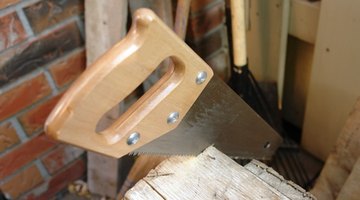How to Sharpen a Bow Saw Blade
Over time as it is used, a bow saw will lose its shape and sharpness. Regular sharpening must be done in order to keep your blade in optimal condition. There are a number of specialty tools required to keep your saw blade sharp.

Most modern saws have hardened teeth, which makes them impossible to sharpen without a diamond file. Older blades are made of softer metals and can be sharpened by more affordable saw files and saw sets.
Things You Will Need
- Flat vile
- Saw vise
- Saw file
- Saw set
-
Fix the saw in the saw vise.
-
With the flat file, file back and forth over the row of teeth until a blunt surface has been made on the point of every tooth.
-
Reshape the saw blade teeth with a three-sided file. Each tooth should receive three to four strokes from the file overall. Repeat this process until all the teeth are the same shape, and the base of the teeth is in a neat line.
-
Bend the teeth of the saw outwards to either side in an alternate fashion. This makes the cut of the saw wider than the blade, so the blade will never catch while sawing.
-
Guide a three-square saw file horizontally through the gap between the teeth. The file should just just clear the jaws of the blade. Sharpen at right angles to the blade if you are working on a rip-cut saw, and at a 60-degree angle if any other type. The back and front of two teeth should be filed together, lifting the file slightly as it returns.
Tip
The edges of the saw file should be slightly rounded. This allows the base of the teeth to have a slight curve.
The Drip Cap
- Over time as it is used, a bow saw will lose its shape and sharpness.
- Most modern saws have hardened teeth, which makes them impossible to sharpen without a diamond file.
- Fix the saw in the saw vise.
- Guide a three-square saw file horizontally through the gap between the teeth.
References
Writer Bio
Preston Manning Bernstein has written in various forms since early childhood. He began publishing articles and feature stories, as well as some of his poetry, short stories, and essays upon enrolling in the College of Charleston. He has written and/or copy-edited for Crazyhorse, Noripcord.com, Gamepositive.com, and various other publications.
Photo Credits
- wood saw image by Horticulture from Fotolia.com
- wood saw image by Horticulture from Fotolia.com
More Articles



